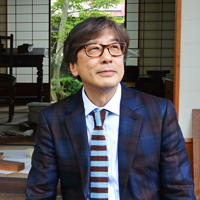Title of Presentation
“The Logos and Lemma of Art”
In the Upper Paleolithic Era, humanoids emerged as Homo sapiens and developed the same brain structure that we now possess. At that time they: developed language that made use of analogy; acquired the ability for pictorial expression; and invented music that had a scalar structure. In other words, Homo sapiens emerged in conjunction with the ability to make art.
Analogy is created by overlaying different fields of meaning. Prior to the Upper Paleolithic Era, human verbal communication was characterized by logos, with words placed sequentially according to syntactical rules. The adoption of analogy rendered Homo sapiens capable of using words for poetic expression, which was entailed the creation of analogic links and the generation of resonance between the parts and the whole through aural reverberation. The use of analogic language structured in this way points to a poetic and musical essence at the very heart of human language. Homo sapiens was born, therefore, when people began speaking a “musical language.”
As examples from European archeology show, Homo sapiens conducted rituals inside caves. We can imagine them in large, pitch-black spaces, drawing pictures on stone walls and singing chorally. Musical utterances in caves led to the discovery of natural harmonics, whose relationships led in turn to the concept of “identity” as people identified a fundamental pitch with the pitch that was one octave higher. Later, the pitches at a perfect fourth and perfect fifth were recognized, providing the natural basis for a pentatonic scale. With this discovery, human music became scalar, a trait that differentiated it from other types of music in the natural world, such as birdsong. Music emerged naturally from the human ability to create language with an analogic structure.
At the same time, it became possible for people to express themselves pictorially with a surprising degree of perfection. Cave paintings of running bison, for example, provide evidence of the intellectual capacity to intuitively and holistically comprehend the subject, project it, and draw it from a single point of view onto the flat plane of a rock wall. Conversely, these ancient artists were also able to imagine the entire animal on the basis of the partial information provided by a projected image.
Homo sapiens evolved with artistic abilities using brains that operated in a “bilogic” fashion by incorporating both linear “logos” and holistic “lemma” capabilities. This has determined the essential nature of human artistic activity to this day. It is impossible to discuss the future relationship between science and art without taking this fact into account.
Profile
- Web Site URL
- http://sauvage.jp
- A brief Biography
-
Born on May 28, 1950 in Yamanashi Prefecture, Professor Nakazawa completed his doctoral course at the Graduate School of Humanities, University of Tokyo and is now active as a theorist and anthropologist. He currently serves as the Director of the Institut pour la Science Sauvage at Meiji University.
After studying Buddhism in Tibet, Nakazawa conceived and developed the research field of “spiritual archeology,” which encompasses the entire realm of human thought. He taught as a professor at Chuo University and served as the Director of Institute for Art Anthropology at Tama Art University before becoming the Director of the Institut pour la Science Sauvage at Meiji University. His many publications include:
Mozart in Tibet (Suntory Prize for Social Sciences and Humanities); A Baroque Thinker in the Forest (Yomiuri Prize for Literature); The East-North of Philosophy (Saito Ryokū Award); Philosophia Japonica (Ito Sei Prize for Literature); Cahiers Sauvages (5 volumes, awarded the Kobayashi Hideo Prize for Vol. 5, Anthropology of Symmetry); Capital in Green; The King of the Spirits; Earth Diver (Kuwahara Takeo Academic Award); Art Anthropology; Wild Science; and The Vast Land of Japanese Literature. More recent works include The Time of Kumagusu’s Star and Diving into a Haiku Sea (co-written with Minoru Ozawa). In recognition of his research achievements, Nakazawa was awarded the 26th Minakata Kumagusu Prize (Humanities Category) in May 2016. - Details of selected Awards and Honors
-
6th Suntory Prize for Social Sciences and Humanities (History and Civilization Category) (1984)
44th Yomiuri Prize for Literature (Criticism/Biography Category) (A Baroque Thinker in the Forest)(1992)
4th Saito Ryokū Award for The East-North of Philosophy (Seidosha) (1996)
12th Ito Sei Prize for Literature (Criticism Category) for Philosophia Japonica (Shueisha) (2001)
3rd Kobayashi Hideo Prize for Anthropology of Symmetry, Vol. 5 of the 5-volume Cahiers Sauvages (Kodansha)(2004)
9th Kuwahara Takeo Academic Award for Earth Diver (Kodansha)(2006)
26th Minakata Kumagusu Prize (Humanities Category) (2016)
- A list of selected Publications
-
Mozart in Tibet (2003・Kodansha)
Concerning a Snowflake’s Curve (1988・Chuokoronsha)
A Baroque Thinker in the Forest (2006・Kodansha)
The King of the Spirits (2003・Kodansha)
Cahiers Sauvages (5 volumes) (2002-2004・Kodansha)
Wildness in a Pocket (2004・Shinchosha)
Earth Diver (2005・Kodansha)/Osaka Earth Diver (2012・Kodansha)
Art Anthropology (2006・Misuzu Shobo)
Wild Science (2012・Kodansha)
The Time of Kumagusu’s Star (2016・Kodansha)






